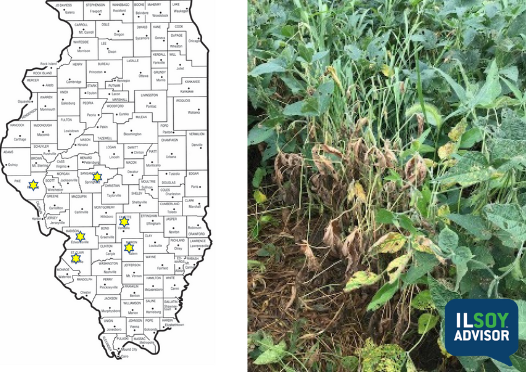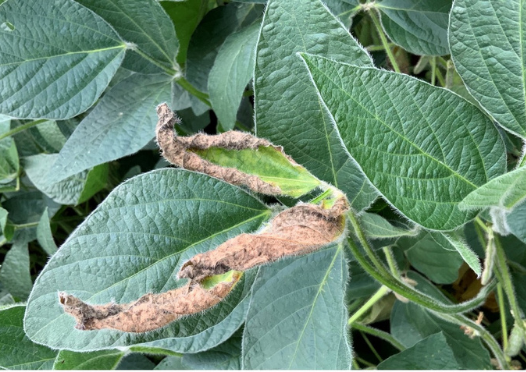ILSOYADVISOR POST
Got a Hanker to Learn about Soybean Stem Canker?
Symptoms of charcoal rot can be mistaken for symptoms of Diaporthe fungi which cause stem canker and pod and stem blight.
The Crop Protection Network has new information on the diagnosis on the soybean stem canker. To start, the Diaporthe-Phomopsis disease complex includes Phomosis seed decay caused by D. longicolla, pod and stem blight caused by D. sojae, and stem canker caused by D. caulvora and D. aspalathi. As a diagnostician, I was taught that if you cut open a soybean stem—usually later in the season—and you saw “zone lines,” this was thought to be associated with charcoal rot but this is NOT TRUE.
Recent discovery has revealed that zone lines within lower soybean stems are now associated with Diaporthe fungi. For more information on zone visit here.
 |
 |
| Soybean stem that had zonate lines associated with Diaporthe spp., which consisted of stem canker. Picture taken by Stephanie Porter. | A patch of stem canker found in soybeans near runoff from a dairy barn. Remember that stem canker is more often found in high fertility environments. Picture taken by Stephanie Porter. |
Several soybean plants can appear to have zonate lines on the inside of the lower stem and roots when stem is split in half. But, to know if soybeans were affected by stem canker, diagnosis is much easier if seen during the growing season. The fungal pathogen that causes stem canker can lurk in soil or residue for many years or it can be seed-borne. Weeds such as black nightshade, curly dock and morning glory can also harbor this disease. Rain, usually with warm weather, splash spores and infect susceptible plants during early vegetative stages and cankers can become visible during reproductive stages.
Once a plant is infected, the fungus can release a toxin that causes leaf interveinal chlorosis, which can also be confused with either brown stem rot or sudden death syndrome. Later, you may spot patches of dead plants with leaves attached, which can be confused with Phytophthora or white mold.
When you see these above ground symptoms, you need to evaluate the lower third of the stem and check for stem canker as well! Cankers (lesions) can be found at the base of the branch or leaf petiole and are more easily spotted when stems are green. Cankers can extend over several nodes on one side of the stem, girdle the stem and kill the plant. Lastly, plants with stem canker don’t have interior taproot discoloration. If you aren’t sure, you may need a laboratory diagnosis.
 |
 |
| Interveinal leaf chlorosis on leaves of a plant infected with stem canker. Picture taken by Stephanie Porter. | Stem canker located lower on the stem near a petiole. Picture taken by Stephanie Porter. |
Back in 2013, while working at the University of Illinois Plant Clinic, I recognized that some susceptible soybean varieties were being planted. The problem is that soybean varieties vary in their susceptibility to stem canker and soybean seed companies may not have disease ratings for this disease. The plant’s susceptibility, early infection and how cankering affects reproduction will determine yield loss. There have only been a few cases where I have witnessed high yield loss caused by this disease, but if environmental conditions are favorable, a susceptible variety can experience up to 50 percent yield loss if this disease is present in your field.
 |
|
The patches of “grayish” soybeans within the circle were heavily infected with stem canker. Picture taken by Stephanie Porter. |
Fields with minimum or no-till as well as high fertility soil/organic matter are at higher risk for stem canker. Tillage and crop rotation to a non-host such as corn, wheat and sorghum can help to reduce inoculum for the next soybean crop, but a 2-year rotation may be needed after a severe infection of stem canker. There are mixed reviews on effective fungicides. A fungicide is only effective if applied during early vegetative stages of susceptible soybean varieties. But, ultimately, as a Burrus Agronomist, it is my job to evaluate soybeans so we can provide varieties that offer better resistance to this disease.
Stephanie Porter is a Sales Agronomist with Burrus® Hybrids with responsibilities that include educating growers and Burrus staff on all types of pests, weeds, diseases and other agronomic issues that affect corn, soybean and alfalfa production. Her territory encompasses Southern Wisconsin as well as Northern, Eastern and Southern Illinois.




Comments
Add new comment